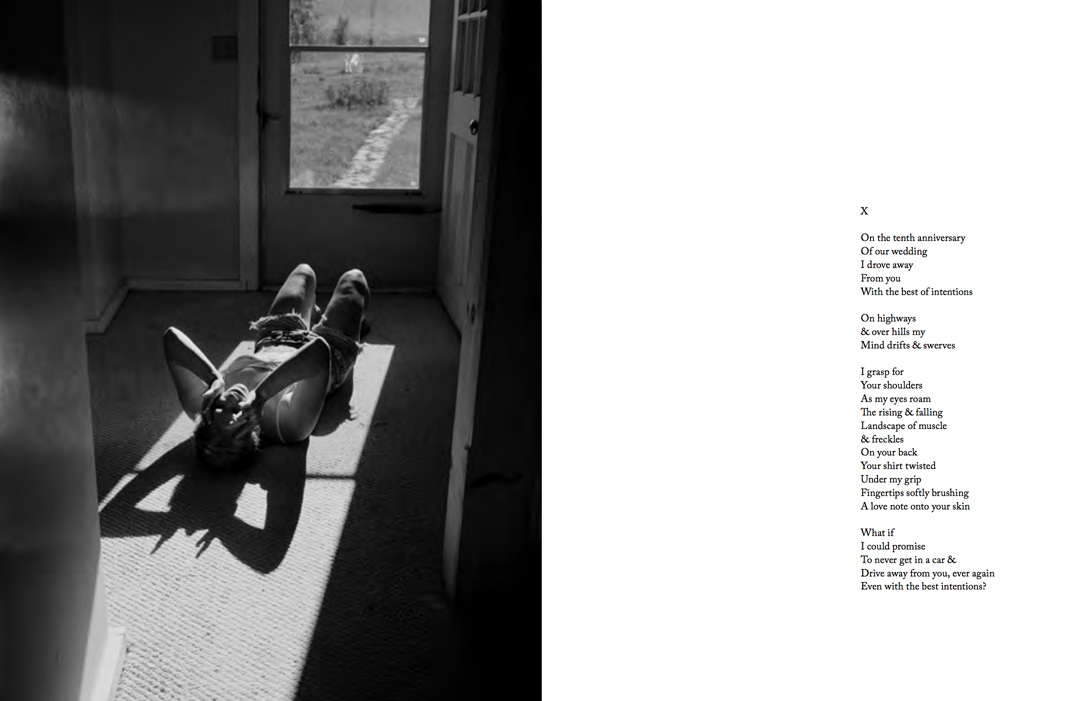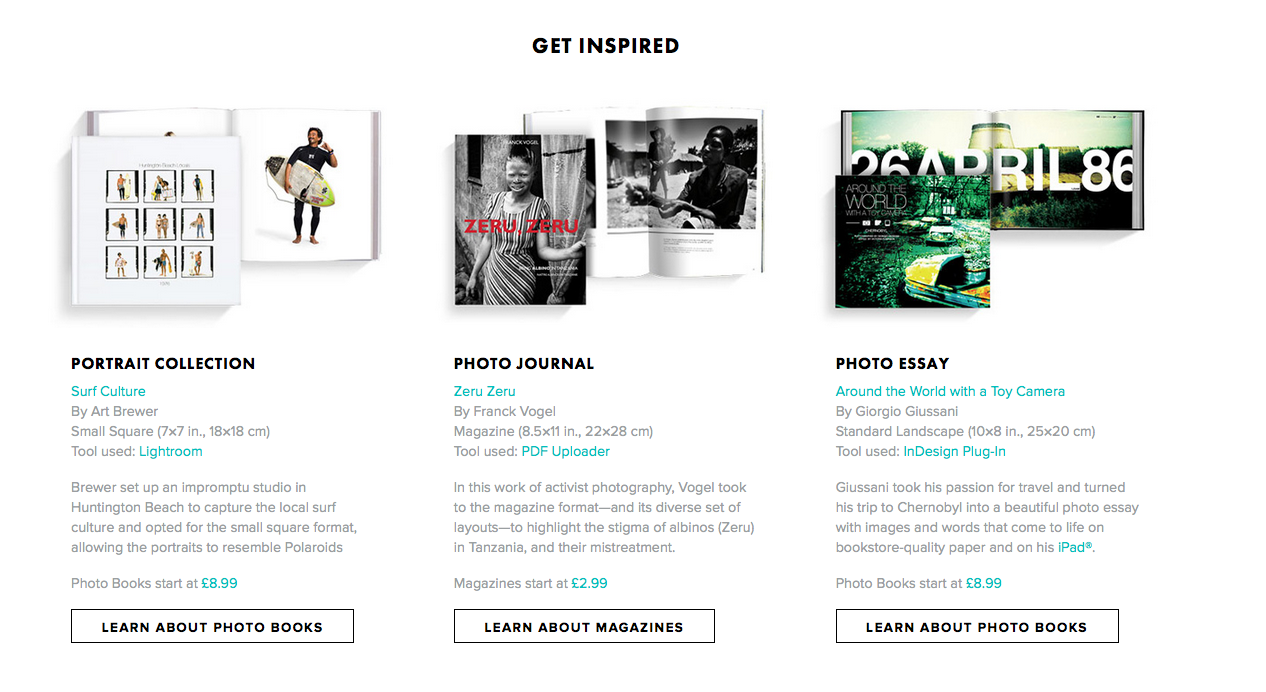For my investigation into a photo book, I will be observing in detail, then discussing the features of Matt Eich’s photo book entitled ‘I Love You I’m Leaving’. I have chosen this book to research because it is the book I will be using in my personal study and Matt Eich is a photographer I have paid close attention to throughout my project thus far. His images are so very poetic and it is a style of documentary photography I am aiming to replicate in my project. The following few blog posts will be dedicated to the research into this photo book and will include discussion surrounding the narrative and features of the book as well as who Matt Eich is and my own options on the book.
Deconstruction of the physical and narrative features of the book:
Book in hand
The book in hand feels very light and small – it can be handled easily and doesn’t feel too heavy.
The cover has a very smooth texture yet a little rough and feels almost like plastic.
Book is a small portrait format.
Paper and ink
The paper is the same throughout – matte paper with solely black and white images printed throughout.
There is no text / captions in the book
There is a coloured image of photographers grandfather at the beginning and the end as it is dedicated to him.
Format, size and orientation
There are 64 pages and 46 photographs.
The edition is softcover with an exposed spine.
The dimensions are 22 x 17 cm.
It is portrait and features images of all sizes.
Design and layout:
Within the book, there are no captions or texts alongside the images. However, there is a poem at the end next to the image where we the wife on the floor in what seems like a breakdown as she looks very uneased by something with her hands on head. I am not certain on what the poem means or who it was written by but it describes driving away from the one you love on a 10th wedding anniversary and feeling a sense of remorse.
Neither are there any fold-outs or inserts.
Landscape Images: 18
Portrait Images: 14
Full Bleed Images: 11
Tipped In Images: 2
Blank Pages: 5
Rhythm and sequencing:
The book starts and ends with very similar images; the first image of the project is of Eich’s daughter sat at a park bench with the light reflecting on her body and she has her eyes closed as she leans on the table. This image image is again shown as the last image to conclude the book but this time with her eyes open and the shadows reduced.
The second image introduces Eich and his wife in a self-portrait where we see Eich, sat down, learning his head against his wife’s bare abdominal as she stands. This is a very powerful image to introduce the wife and husband.
From this point, it seems as though every juxtaposes one another in the sequence they have been printed. There doesn’t seem to be an order yet that all work in conjunction with one another.
It is as though we physically take a journey through the busyness of family life as the husband and wife spend time with their children and as we are introduced to new characters throughout.
Structure and architecture:
The book, unlike other photo books simply consist of solely images which often don’t seem to have nay relation to one another and so it may, at first be difficult to derive nay meaning from the imagery and decipher the story which is wanting to be represented which is what I experienced at first . However, there seems to be a running theme of finding a balance between emotions, events and feelings. It starts at an equilibrium which seems to gradually crumble and become an imbalance of emotions within all family members and this is presented in the photographs as we people confiding in one another, and more serious facial expressions, if we see any at all because often, faces are covered with hands to hide the sadness. People seem to be less involved in their familial circle and daughters, the wife and Eich’s parents seem to become isolated from what once was an equilibrium.
Narrative:
The story is told from the perspective of Eich himself as a father, son and husband and focuses on all 3 of these elements of family life to tell a narrative of love, connections and detachments. Eich, although at the centre of it all, does not make this clear and instead focuses on the presence of his family members and how this provides a base for he life they all lead. Eich himself states that the book follows his documentation of what he experiences within his own familial circle as he, on regular basis makes connections with his daughters through his love for his wife and this welcomes an interaction between himself and his parents. The narrative can also tell a story of generations and how this is, even though very broad from elderly to youth, can actually connect a family through the relationships that build over this concept of ‘knowing our place in this fragile world’ as Eich states. This is shown in the image which includes the book where we one of Eich’s daughters sat by the coffin of Eich’s grandfather and even though this man is not present in the book’s content through, it reiterates the importance of remaining close because without that knowing of belonging, people can become so easily isolated which I explore in my own project through the main body looking at belonging; it provides an underlying guilt of not being present and instead being contained within yourself, something I have recently become a victim of and I am attempting to include this emotion in my project as I have become much more aware of my own feelings since starting this book. I see my own project as an experiment of truth and showing everything as it is – by not covering anything for the lens or presenting anything false for the camera. My aim and intent is for this to make my project more raw and real by not altering things to make them more “acceptable” because then photography does not become interesting and it removes that ability to connect with imagery once the rawness of what you are capturing has been discarded.
In Eich’s project, he does not attempt to tell a story of sorrow or upset and instead looks to simply present his family and the rawness of their respect and love for each other – this what I get and feel form looking and flicking through his book.
Title:
The title is literal but it is also poetic. The title ‘I Love You I’m Leaving’ I imagine was carefully chosen by Eich but once chosen would have been easily imagined because of it’s compete literal meaning. The story follows the split of his mother and father after over 30 years of marriage and how this break-away coincides with the departure if Eich and his newly formed family to a new city. It looks forming a new identify from what Eich used to be – from his mother and father’s careful nurturing to raise Eich to the man he is now has benefitted his ability to build his own relationships, however, occurring at the time of what once was a happy family’s physical and emotional detachment as he moves away, leaving his mother and father suffering on their own, also away from one another. The title, knowing this synopsis of the project, seems very suited and it does work very well. It also connotes the popular phrase of what people say to one another if they are about to leave an event or situation etc. but don’t rally want to and it is not out of their own will – people often say ‘I’ll love you and leave you’ as they say goodbye and this essentially what Eich is doing. It does very intrigue the audience because it opens the door to what is to come.
Images and text:

There is one piece of text throughout the hole book, excluding the two texts at the beginning and end which dedicates the book to Eich’s grandfather and this is the pome towards the latter of the book (shown above). It is a poem on a blank page next to a full bleed image of Eich’s wife lying on the floor. There are no captions or anything else apart from this four verse poem. I am not actually fully sure of the meaning of the pome and or what it’s intent on the audience is or who’s perspective it is actually from. However, I am imagining it is either rom Eich’s perspective to his wife or I thin that the most likely option is that it is written by Eich about his father’s divorce from his mother as it follows a story of leaving the said and feeling some sense of remorse but still a sense of love. I also believe the title of the poem is ‘X’ – most likely connoting a kiss in text talk.










